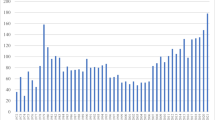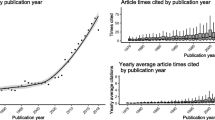Abstract
This paper provides a citation network analysis of the publications of the journal Higher Education from 1972 to 2014 inclusive. This represents nearly the entire history of the journal. It analyses the most published authors and the most cited articles, as well as the most cited authors. This data includes the highest number of publications both by institution and country of origin. 2176 articles were taken from Web of Science™ as a source of primary data. These articles were found to have 68,009 references. Analysis was carried out using the Web of Science™ online analytics tool and Excel®. Gephi™, a data visualisation and manipulation software, was then used to provide visual representations of the associated citation networks. These representations were shown to constitute “terrains” of citations or “geographies of influence”—effectively bringing to bear empirical data in support of Macfarlane’s higher education research “archipelago”. Nationality biases were observed between US and UK/European/Australian higher education journals. Results indicate that the most published authors throughout the journal’s history are Meyer, Kember, Richardson, Enders and Prosser. Confirming earlier studies on UK and Australian journals, the five most cited authors are Entwistle, Clark, Marton, Biggs and Ramsden. The single most cited article is Clark’s 1983 Higher education system: academic organization in cross-national perspective. The top publication years for the journal were 2012, 2009 and 2011. Results from this paper shed light into the evolving concerns of the journal and its readership, and provide a demonstration of a powerful way of analysing citation data.
Similar content being viewed by others
References
‘About this journal’. (2015). Higher Education: The International Journal of Higher Education Springer. http://www.springer.com/education+%26+language/higher+education/journal/10734
Anglin, G. J., & Towers, R. L. (1991). Citation networks of selected instructional design and technology journals, 1985–1990. ED334970. http://eric.ed.gov/?id=ED334970.
Bodenhorn, H. (2003). Economic scholarship at elite liberal arts colleges: A citation analysis with rankings. The Journal of Economics Education, 34(4), 341–359.
Bornmann, L., Leydesdorff, L., & Marx, W. (2007). Citation environment of Angewandte Chemie. CHIMIA, 61(3), 104–109.
Brughmans, T. (2012). Connecting the dots: Toward archeological networks analysis. Oxford Journal of Archaeology, 29(3), 277–303.
Bruner, M. W., Erickson, K., Wilson, B., & Côté, J. (2010). An appraisal of athlete development models through citation network analysis. Psychology of Sport and Exercise, 11(2), 133–139.
Budd, J. M. (1990). Higher education literature: Characteristics of citation patterns. Journal of Higher Education, 61(1), 84–97.
Budd, J. M., & Magnuson, L. (2010). Higher education literature revisited: Citation patterns examined. Research in Higher Education, 51(3), 294–304.
Calma, A., & Davies, W. M. (2015). Studies in Higher Education 1976–2013: A retrospective using citation network analysis. Studies in Higher Education, 40(1), 4–21.
Cho, Y., & Park, S. (2012). Using citation network analysis in educational technology. Educational Technology, 52(3), 38–42.
Griggs, R. A., & Collisson, B. (2013). ToP’s greatest hits: The most frequently cited Teaching of Psychology articles. Teaching of Psychology, 40(2), 76–87.
Healy, K. (2013). A Co-citation network for Philosophy. http://kieranhealy.org/blog/archives/2013/06/18/a-co-citation-network-for-philosophy/.
Howard, J. (2011). Citation by citation, new maps chart hot research and scholarship’s hidden terrain (cover story). Chronicle of Higher Education, 58(4), A1.
Huisman, J. (2008). Higher education policy: The evolution of a journal. Higher Education Policy, 21(2), 265–274.
Kandlbinder, P. (2012). Recognition and influence: The evolution of higher education research and development. Higher Education Research and Development, 31(1), 5–13.
Klein, W. C., & Bloom, M. (1992). Studies of scholarly productivity in social work using citation analysis. Journal of Social Work Education, 28, 291–299.
Leydesdorff, L. (2007). Visualization of the citation impact environments of scientific journals: An online mapping exercise. Journal of the American Society for Information Science and Technology, 58(1), 25–38.
Macfarlane, B. (2012). The higher education research Archipeligo. Higher Education Research and Development, 31(1), 129–131.
Moore, S., Shiell, A., Hawe, P., & Haines, V. A. (2005). The privileging of communitarian ideas: Citation practices and the translation of social capital into public health research. American Journal of Public Health, 95(8), 1330–1337.
Nightingale, J. M., & Marshall, G. (2012). Citation analysis as a measure of article quality, journal influence and individual researcher performance. Radiography, 18, 60–67.
Rangeon, S., Gilbert, W., & Bruner, M. (2011). Mapping the world of coaching science: A citation network analysis. Research Quarterly for Exercise and Sport, 82(1), A50–A51.
Ross, A. M. (1992). Two decades of higher education. Higher Education, 23(2), 99–112.
Thyer, B. A., & Bentley, K. J. (1986). Academic affiliations of social work authors: A citation analysis of six major journals. Journal of Social Work Education, 22(1), 67–73.
Tight, M. (2008). Higher education research as tribe, territory and/or community: a co-citation analysis. Higher Education, 55(5), 593–605.
Tight, M. (2014). Working in separate silos? What citation patterns reveal about higher education research internationally. Higher Education, 68(3), 379–395.
Westbury, I. (1980). The impact of the journal of curriculum studies: A citation analysis. Curriculum Studies, 12(2), 149–156.
Xian, H., & Madhavan, K. (2013). Building on and honoring forty years of PBL scholarship from howard barrows: A scientometric, large-scale data, and visualization-based analysis. Interdisciplinary Journal of Problem-Based Learning, 7(1), 132–156.
Author information
Authors and Affiliations
Corresponding author
Rights and permissions
About this article
Cite this article
Calma, A., Davies, M. Geographies of influence: a citation network analysis of Higher Education 1972–2014. Scientometrics 110, 1579–1599 (2017). https://doi.org/10.1007/s11192-016-2228-3
Received:
Published:
Issue Date:
DOI: https://doi.org/10.1007/s11192-016-2228-3















